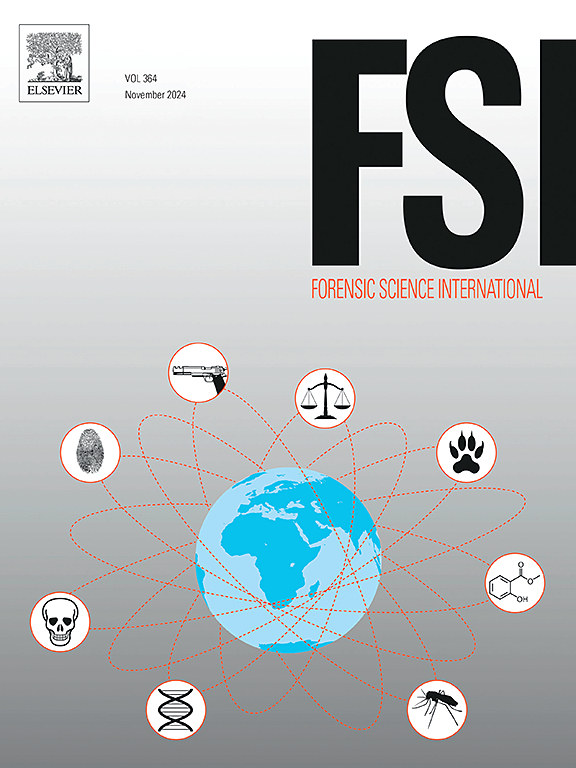Distinctiveness of the sphenoid sinuses for human identification: A cone beam computed tomography study
IF 2.2
3区 医学
Q1 MEDICINE, LEGAL
引用次数: 0
Abstract
Human identification in complex cases, such as charred skeletal remains and advanced decomposition, requires reliable methods to associate the identity of a missing person with an unidentified body. Among the different types of human identification, radiological methods are effective as they generally allow qualitative and quantitative analysis of anatomical, pathological, and therapeutic peculiarities, whose combination of information forms a unique set of characteristics that can lead to a positive identification. In this context, the present study aims to evaluate the distinctiveness of the sphenoid sinuses, and to classify and identify their morphological patterns in the studied population, with potential application for human identification. This retrospective observational study analyzed 91 cone beam computed tomography (CBCT) scans of Brazilian individuals (34 males; 57 females) over the age of 25 years. A qualitative analysis was performed focusing on the sphenoid sinuses' morphological pattern, as well as their presence, number, and position in sagittal and axial CBCT slices. The sphenoid sinuses were present in 100 % of cases, 48.3 % had one septum, 30.7 % had two septa, and 20.8 % had three intersphenoidal septa. Septa type 3 (in the midline) were the most common (42.9 %; n = 39), while type 4 (slightly left to the midline) were the least frequent (3.3 %; n = 3). In the sagittal section analysis, post-sellar type (IVa) septa were the most frequent (50.5 %; n = 46), while the pre-sellar type septa were the least frequent (14.3 %; n = 13). The turbinate pattern (type I) was not detected in this study. From an anatomical point of view, great morphological and dimensional variability were found between the sinuses. It was possible to observe qualitative and quantitative morphological differences that allow the individualization of the sphenoid sinus, which can support human identification.
人类识别蝶窦的独特性:锥束计算机断层扫描研究
在复杂的情况下,如烧焦的骨骼遗骸和深度分解,需要可靠的方法将失踪者的身份与身份不明的尸体联系起来。在不同类型的人体识别中,放射学方法是有效的,因为它们通常允许对解剖、病理和治疗特性进行定性和定量分析,这些信息的组合形成了一组独特的特征,可以导致积极的识别。在此背景下,本研究旨在评估蝶窦的独特性,并在研究人群中分类和识别其形态模式,并具有潜在的应用于人类识别。这项回顾性观察性研究分析了91个巴西个体的锥束计算机断层扫描(CBCT)扫描结果(34名男性;57名女性),年龄在25岁以上。我们对蝶窦的形态模式以及蝶窦在矢状和轴向CBCT切片上的存在、数量和位置进行了定性分析。100 %的病例存在蝶窦,48.3 %有一个鼻中隔,30.7 %有两个鼻中隔,20.8 %有三个蝶间鼻中隔。间隔3型(中线)最常见(42.9% %;N = 39),而4型(稍微偏左到中线)最不常见(3.3 %;n = 3)。矢状面分析中,鞍后型(IVa)间隔最常见(50.5 %;N = 46),而预售型鼻中隔发生率最低(14.3 %;n = 13)。本研究未发现甲骨型(I型)。从解剖学的角度来看,在鼻窦之间发现了巨大的形态和尺寸变化。有可能观察到定性和定量形态学差异,从而使蝶窦个体化,这可以支持人类的识别。
本文章由计算机程序翻译,如有差异,请以英文原文为准。
求助全文
约1分钟内获得全文
求助全文
来源期刊

Forensic science international
医学-医学:法
CiteScore
5.00
自引率
9.10%
发文量
285
审稿时长
49 days
期刊介绍:
Forensic Science International is the flagship journal in the prestigious Forensic Science International family, publishing the most innovative, cutting-edge, and influential contributions across the forensic sciences. Fields include: forensic pathology and histochemistry, chemistry, biochemistry and toxicology, biology, serology, odontology, psychiatry, anthropology, digital forensics, the physical sciences, firearms, and document examination, as well as investigations of value to public health in its broadest sense, and the important marginal area where science and medicine interact with the law.
The journal publishes:
Case Reports
Commentaries
Letters to the Editor
Original Research Papers (Regular Papers)
Rapid Communications
Review Articles
Technical Notes.
 求助内容:
求助内容: 应助结果提醒方式:
应助结果提醒方式:


